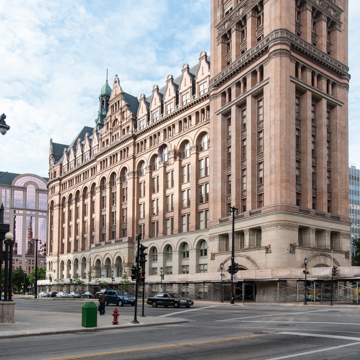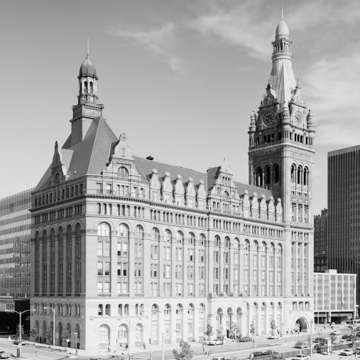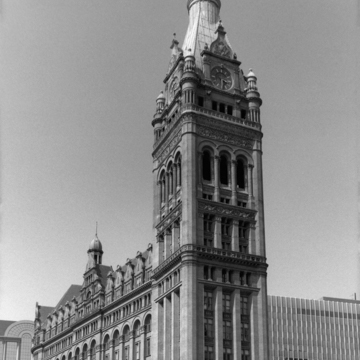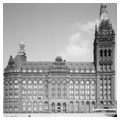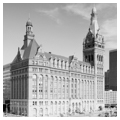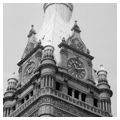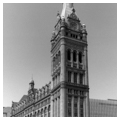For the greatest single monument to Milwaukee’s past history, look no further than City Hall. The building’s massive, triangular, eight-story body and 350-foot tower dominate the central business district. German-born architect Henry Koch created a building that many believe to be modeled on a German town hall. While some German examples do have tall towers and dormers at the roofline, this is an American design. The main body of the building is divided into arched bays that enclose several stories of windows, a coordinating device used in innumerable commercial buildings and warehouses in major cities. Koch gave the building a gray granite and Berea sandstone foundation to support maroon brick cladding over a steel frame. The broad Syrian arches of the entrances at the base of the tower and the sense of ponderous weight recall work by Louis Sullivan and H. H. Richardson. Flemish-style gables line the eaves and dormers, punctuating the steep slate roof and ornamenting the tall bell tower capped with a conical, verdigris copper spire. Koch borrowed guiding ideas, but on his own he populated the exterior with terra-cotta and stone cherubs, grotesque faces, griffins, and wolves’ heads.
Inside, a skylit, diamond-shaped light court soars eight stories high and is surrounded by walkways and offices. Embellishments include a mosaic floor, oak woodwork, marble wainscoting, and stencil designs re-created in 1992 from the originals. Cyril Colnik’s bronze-finished iron railings include dragons and other fantastical creatures among the leaves.
Milwaukee’s first seat of government occupied this site, but as the city grew rapidly in the 1880s, citizens recognized the need for a larger city hall. Political wrangling delayed action until 1891, when the Common Council announced a competition for the design. Hamburg-born Mayor John C. Koch took office in 1893, and the city approved a new building by the mayor’s fellow Deutscher Club member Henry C. Koch, who won the design competition over ten other entries with his Americanized version of a German Renaissance rathaus (town hall), with four “beer stein” turrets flanking its imposing bell tower. By its completion in 1895, more than half of Milwaukee’s population was either German-born or second generation German American, and the city hall’s Germanic styling mirrored the city’s reputation as the “Deutsch Athens.” The size, elaboration, and Germanic references all express local ambition to create a great city in midwestern America that proudly proclaimed the heritage of its leaders.





















